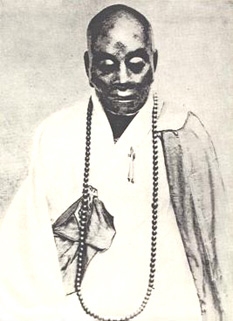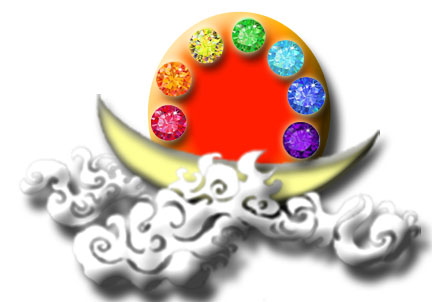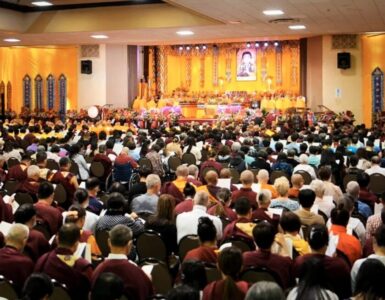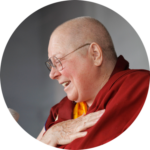
The second chant, done every morning and known as “The Four Bodhisattva Vows,” is from our refuge ceremony and one of the set of vows taken when you become a Buddhist:
The Four Bodhisattva Vows
“Defilements are countless; I vow to put an end to them.”
“Dharma methods are limitless; I vow to learn them.”
“Living beings are innumerable; I vow to save them.”
“Buddhahood is unsurpassable; I vow to realize it.”
Los Cuatro Vows* del Bodhisattva
“Las impurezas son incontables; Hago el vow de ponerle fin a todas ellas.”
“Los métodos de Dharma son ilimitados; Hago el vow de aprenderlos todos.”
“Los seres vivos son innumerables; Hago el vow de salvarlos a todos.”
“La Budeidad es insuperable; Hago el vow de realizarla.”
Most Mahayana Buddhist groups include this chant, sometimes adding “Great” as it represents the seemingly impossible vows that all Bodhisattvas make. It exists in many forms with differing interpretations. It probably originated in China, but may have had an even earlier Sanskrit version as a four line “gatha.” The Sanskrit term gatha is used in Buddhism for short, often four line, verses that have a poetic meter and may be spoken, sang, recited or mentally done in rhythm with the breath as part of a mindfulness or other practice.
We know this chant goes back to the Sixth Patriarch Huineng and was brought to Japan very early. D. T. Suzuki introduced it to America in 1935. The Japanese Zen temples where I practiced chanted it daily, sometimes in English and sometimes in Japanese.
The version that we chant of this vow summarizes very nicely the core teachings of H.H. Dorje Chang Buddha’s Learning From Buddha. You start with cultivation and put an end to your defilements and do only good. Then you are able to learn and practice dharma. With dharma you can train or cultivate your mind and gain concentration and with that you gain wisdom. Having concentration and wisdom, you are able to save living beings and eventually realize Buddhahood. Other versions often start with vowing to save all living beings first, but how can you do that before you save yourself? We need to start with cultivation and work to actually eliminate our defilements of anxiety, hate, greed, etc. “Dharma gates” is often used instead of “dharma methods” and may be a better term. I think the reason for the other methods of stating these vows used by other groups reflect the all too common belief that enlightenment is not possible in this lifetime in these “dharma-ending” days. That is not the teaching of H.H. Dorje Chang Buddha III.
Roshi Robert Aitken provides some background on this universal chant: “The four Great Vows express aspirations relating to the Three Treasures of Buddhism (The Buddha, The Dharma, and The Sangha): to redeem the sangha, to stop debasing the Three Treasures, to perceive the dharma clearly, and to attain buddhahood. As such, the Vows are a recasting in the Mahayana of the Ti-sarana-gamana, the ceremony of taking refuge in the Three Treasures, that is found in all Buddhist traditions.”
Roshi Aitken also states that “beginning students commonly ask how they can honestly vow to save all beings. It sounds like missionary arrogance and some are reluctant to take this vow for that reason. Huineng offers a response: ‘You are saving them in your own mind.’ It is bodhichitta that you are cultivating—your own aspiration for wisdom and compassion, and your determination to practice it in the world as best you can.” We hold that this is part of your training or expanding your mind to think, act, and speak like a Bodhisattva, and in so doing actually becoming one, but this is based on actual, concrete acts–not just aspirations. The dharmas that we practice every day are like the training wheels on a bicycle. You need them until you can awaken and have prajna. Once you awaken, you continue cultivation until you reach perfection and become a buddha. That is not the way Buddhism is taught today in America.
H.H. Dorje Chang Buddha III goes further and teaches us that this is what we must do. We do not just “aspire” to these great goals, although that may be the first step. Through our realization of intrinsic-reality prajna, we are able to do what is impossible for ordinary beings. You will learn more about this in Expounding the Absolute Truth through the Heart Sutra and in the Sutra on Definitive Truth. The beauty of His teachings is that He gives practical things that you actually do. Cultivation is not just theoretical Buddhism. He offers so much more than the hollow Buddhist Studies approach of other teachers, although there is much we can learn from other traditions and we should not slander other methods taught by the Buddha.
* Please note that we did not try and translate “vows” into Spanish as there were differing opinions on what would be the best translation for such an essential word. Our translators come from different Spanish-speaking countries and cultural backgrounds. They both had strong opinions on what term to use and I felt they were both correct. We will continue to leave the English or Chinese term if there is any difference or uncertainty as to meaning or cultural usage. We know that these translations, like much of what we have in English can only be used for reference and are not approved as correct Buddha-dharma, but that they still offer great insight into the teaching of the Buddhas. We can only pray that we may soon have many enlightened scholars who can translate directly from Sanskrit, Chinese, and/or Tibetan into Spanish (and English).
CLICK for link to article in Tricycle by Robert Aitken (1917-2010) on how this chant evolved in his sangha in Honolulu. However, you really need to have heard or read our Buddha Master’s discourse on “Prajna” and other parts of Expounding the Absolute Truth through the Heart Sutra and/or the Sutra on Definitive Truth to be able to understand the deeper meaning of this simple vow and to appreciate the profundity of the Buddha Master’s teachings and how fortunate we are to have the words of a Buddha.
CLICK for extensive Wikipedia article, but the same comments above apply.
CLICK for article on Chant Book.
CLICK for Index to all articles on individual Chants. This will be updated as more chants are added to blog.




Add comment